|
Lexus IS
Debut: 2005
Maker: Toyota
Predecessor: Lexus IS / Toyota Altezza Mk1 |
|
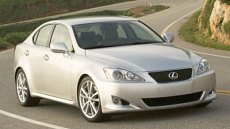 In
1999, Toyota wanted to replicate the success of BMW 3-series with its
first generation Lexus IS (and its Japanese version Toyota Altezza).
Although it tried very hard, and surprised motoring journalists by its
sharp handling, it didn't quite succeed. First of all, the IS looked
ugly compare with an European premium car. Secondly, the IS200 was
underpowered, while IS300 was nose heavy (blame to that Supra-sourced
iron-block straight-6). Thirdly, it was less rounded than the BMW, no
matter the way it dealt with road irregularities or high speed
cruising. Lastly, its hardcore character was out of sync with Lexus'
creamy smooth character. In
1999, Toyota wanted to replicate the success of BMW 3-series with its
first generation Lexus IS (and its Japanese version Toyota Altezza).
Although it tried very hard, and surprised motoring journalists by its
sharp handling, it didn't quite succeed. First of all, the IS looked
ugly compare with an European premium car. Secondly, the IS200 was
underpowered, while IS300 was nose heavy (blame to that Supra-sourced
iron-block straight-6). Thirdly, it was less rounded than the BMW, no
matter the way it dealt with road irregularities or high speed
cruising. Lastly, its hardcore character was out of sync with Lexus'
creamy smooth character.
Having learned the lesson, the second attempt should be more
successful. Rumor has that Toyota hired car design master Leonardo
Fioravanti to pen the new IS. If you are a loyal reader of AutoZine,
you must remember Fioravanti is my favourite car designer and his
masterpieces include Ferrari Dino, Daytona, 512BB and 308GTB. Both
Toyota and Fioravanti did not deny that, thus I would say we can
believe the rumor. Moreover, Toyota's own stylists seems incapable of
creating such a high quality design. Compare with BMW and Audi rivals,
the new IS looks sleeker, more civilized yet no less distinctive. If
the 3-Series and A4 were musclemen, then the IS would be a gentleman.
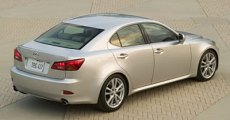 The new Lexus IS is noticeably
bigger than the car it replaced. Compare with the latest E90 3-Series,
it is 55 mm longer but 22 mm narrower. The 2730 mm wheelbase is 60 mm
longer than the outgoing car, but still 30 mm shorter than the BMW.
Basically, you can see it as a smaller version of Lexus GS. It shares
platform with its bigger brother, i.e. aluminum double wishbone front
and multi-link rear suspensions, speed-sensitive electric power
steering, 6-speed automatic transmission with paddle shift, VDIM
vehicle dynamic integrated management program…. however, to save money
and to please keen drivers, the VGRS variable ratio steering rack has
been deleted. The new Lexus IS is noticeably
bigger than the car it replaced. Compare with the latest E90 3-Series,
it is 55 mm longer but 22 mm narrower. The 2730 mm wheelbase is 60 mm
longer than the outgoing car, but still 30 mm shorter than the BMW.
Basically, you can see it as a smaller version of Lexus GS. It shares
platform with its bigger brother, i.e. aluminum double wishbone front
and multi-link rear suspensions, speed-sensitive electric power
steering, 6-speed automatic transmission with paddle shift, VDIM
vehicle dynamic integrated management program…. however, to save money
and to please keen drivers, the VGRS variable ratio steering rack has
been deleted.
But to beat BMW, Toyota understand it must develop better engines. And
this is where the new IS really shines. The latest BMW 330i has a 258
horsepower 3.0 Valvetronic straight-6. That's remarkable, but the Lexus
has a new 3.5-litre direct injection V6 good for 306 horsepower (SAE)
(or even 318 hp at its home market) ! this eclipses Honda Legend to be
the most efficient mass production 6-cylinder engine in the world. With
over 300 horsepower under the hood, no wonder IS350 can storm to 60 mph
in no more than 5.5 seconds, beating all rivals easily. And remember,
it does that with a 6-speed automatic gearbox.
 Admittedly, IS350 does not have
any manual gearbox on offer. If you insist to shift by yourself, you
can choose only IS250, whose 2.5-litre V6 pumps out 204 horsepower.
This is less than BMW 325i (218hp) and, unfortunately, it is also the
car European market will be offered. Another engine for Europe is a 177
hp 2.2-litre common rail diesel four cylinder engine. It shares with
Toyota Avensis. Admittedly, IS350 does not have
any manual gearbox on offer. If you insist to shift by yourself, you
can choose only IS250, whose 2.5-litre V6 pumps out 204 horsepower.
This is less than BMW 325i (218hp) and, unfortunately, it is also the
car European market will be offered. Another engine for Europe is a 177
hp 2.2-litre common rail diesel four cylinder engine. It shares with
Toyota Avensis.
The bigger V6 is similar to that being used by the American Toyota
Avalon, but is turned to mount longitudinally in the engine bay of
Lexus. Naturally, it has four camshafts, 24 valves and dual VVT-i. Now
added with direct injection to raise compression ratio to 11.8: 1 hence
more power. Unusually, the D-4 system has both direct injection and port injection,
the latter is useful when air flow is slow. However, the biggest
advance of the new engine is weight distribution - the all-aluminum
construction makes it lighter than the old iron-block straight-6 while
the compact size of V6 allows it to mount closer to the cabin. Overall,
the IS350 has 53 percent of weight acted on the front axle. That's no
match with the magnesium engine BMW 3-Series, of course, but already an
improvement
from the old IS300.
On the Road
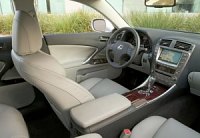 Open the doors, you will be
amazed by how cramped the rear cabin is. Although the car is much
larger than the old one, it is no more spacious inside. Tall passengers
will find legroom and headroom tight at the rear seats. The GS with
equivalent engine is just 40 kg heavier, but it offers a much roomier
cabin. Seems that the new IS does not use space and weight efficiently. Open the doors, you will be
amazed by how cramped the rear cabin is. Although the car is much
larger than the old one, it is no more spacious inside. Tall passengers
will find legroom and headroom tight at the rear seats. The GS with
equivalent engine is just 40 kg heavier, but it offers a much roomier
cabin. Seems that the new IS does not use space and weight efficiently.
The
dash design does not have the elegant feel of Audi, but materials and
build quality remains to be the strength of Lexus. Ditto the luxurious
equipment such as a superb Mark Levinson sound system, high-spec color
monitor and navigation system, voice control and countless of airbags.
Also
match your expectation for Lexus is the refined ride quality and
excellent noise insulation. The V6 idles in silence and spins silky
smooth in any rev. The 6-speed automatic transmission shifts
seamlessly. At high speed, the slippery (Cd 0.28) body generates little
wind noise, while the liquid-filled rubber bushings isolate NVH from
the suspensions to the cabin very well. In terms of mechanical
refinement, Lexus is still the leader.
That's for the IS250, but the combination of 204 hp, 185 lbft and 1570
kg result in a rather leisure performance, while the soft-set
suspensions cannot excite its driver in the same way as BMW 325i.
That's why you need to try the IS350 with Sport package, which is very
different.
 The big V6 is still very smooth
and quiet, probably too quiet for a sports sedan. Nevertheless, when
you ask from it, its flat power band delivers storming acceleration so
effortlessly. The sports suspensions with aggressive rubbers keep the
body well controlled. The big brakes (come from GS430) provide
excellent stopping power. The big V6 is still very smooth
and quiet, probably too quiet for a sports sedan. Nevertheless, when
you ask from it, its flat power band delivers storming acceleration so
effortlessly. The sports suspensions with aggressive rubbers keep the
body well controlled. The big brakes (come from GS430) provide
excellent stopping power.
However, apart from performance, the Lexus in no way matches BMW 330i.
First of all, the sports suspensions are overdamped and transmit too
much shocks to the cabin. This mean it is not an all-round package like
the BMW. Then you will notice the driver interface is far from
intimate: the electric power steering is too light and lacks feel,
while the paddle shift gearbox reacts slowly. But worst of all is that
it succeeded the biggest failure of GS430: VDIM. The electronic
stability management system intervenes too early and too eagerly to
protect its baby. And it cannot be switched off ! this mean the IS350
can never exploit the limit of its aggressive rubbers and suspensions.
Will the car understeer heavily at the limit? can it play throttle
oversteer? these questions suddenly become silly to the IS350, because
VDIM will stop the party before you get the answers.
The new Lexus IS350 is such a ridiculous car. It set out a target to
beat BMW, but it turned out to be even less driver satisfying than the
first generation IS. It seems to be engineered by some people who don't
know what made BMW 3-Series so successful. Although Car And Driver
ranked it second to the BMW, I would say this is one of the most
disappointing cars of the year.
|
| The
above report was last updated on 4 Oct 2005. All Rights Reserved. |
|
IS220d
|
So
the new IS350 and IS250 are disappointing. What about the European
diesel version? this is the cheapest of the range, also the most
frugal, with a combined consumption 44.8 mpg. Its 2.2-litre turbo
diesel four generates 177 horsepower and a very strong 295 lbft of
torque, so performance nearly matches the petrol IS250. Furthermore,
its suspension has been retuned for European taste. Can it give BMW
320d a good fight?
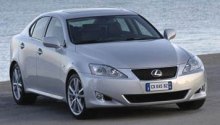 The answer is again no. First
to take the responsibility is the diesel engine. While the spec looks
good (aluminum block, 16 valves, 1800 bar piezo-electronic
third-generation common-rail injection and variable vane turbocharger),
and the ultimate power is strong, the engine is rather weak below 2000
rpm. There is a slight turbo lag that rarely associate with a premium
diesel engine today. Ditto the booming noise at hard work and the
vibration through the pedals. You won't see this in BMW, Mercedes and
Audi's diesel engine, but you will see exactly the same things at a
Toyota Avensis and Corolla Verso diesel, because they actually share
the same engine. This is undoubtedly a disappointment to a brand
traditionally so strong at refinement. The answer is again no. First
to take the responsibility is the diesel engine. While the spec looks
good (aluminum block, 16 valves, 1800 bar piezo-electronic
third-generation common-rail injection and variable vane turbocharger),
and the ultimate power is strong, the engine is rather weak below 2000
rpm. There is a slight turbo lag that rarely associate with a premium
diesel engine today. Ditto the booming noise at hard work and the
vibration through the pedals. You won't see this in BMW, Mercedes and
Audi's diesel engine, but you will see exactly the same things at a
Toyota Avensis and Corolla Verso diesel, because they actually share
the same engine. This is undoubtedly a disappointment to a brand
traditionally so strong at refinement.
On the road, the IS220d doesn't feel as quick as BMW 320d. It doesn't
handle or ride as good too. The over-light steering is still detached
from the road. However, the notorious VDIM is found less intrusive in
this car, probably because the IS220d offers less grip and corners less
hard than the IS350, so it needs to push much harder to get the
electronic aids intervening.
Anyway, this is the first ever diesel Lexus. Maybe we should not expect
too much from it. Although it is likely to be the best selling IS in
Europe, it still represents a small number compare with the IS250 and
IS350 sold in the USA and home market, where diesel is not offered. As
a result, Lexus could not afford to spend big development budget on it.
This explain why it has to share the same engine with the cheap Toyota
models.
|
| The
above report was last updated on 20 Nov 2005. All Rights Reserved. |
|
IS-F
|
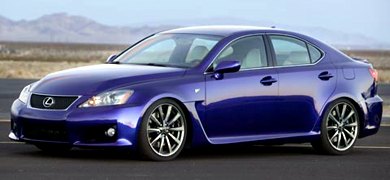
|
Aftermarket looks hide a big V8 and
German-rivaling performance. But is it a match to the German in driver
appeal ?
|
In
the beginning, Lexus invaded the premium car market by offering
refinement beyond the reach of European rivals. Having succeeded in the
USA and Asia market, it got more confident and started expanding its
lineup. Lexus IS was the first product to lure younger European
customers from the likes of BMW 3-Series. At the other end, LS600h
taught the German a lesson about innovative green technology. So far so
good. The unstoppable force from Japan is now expanding into a
battlefield previously reserved for BMW's M-division, Mercedes' AMG
division and Audi's RS-lines. The mission of Lexus IS-F is clear: to
gun down M3, C63 and RS4. The German must be trembling.
The headline facts and figures of IS-F must be its 5.0-liter V8,
derived from the one serving LS600h sans the hybrid accessories.
Toyota's old friend Yamaha helped tuning the engine, giving it new
high-flow cylinder heads, titanium intake valves, higher valve lift,
lightweight hollow camshafts, solid lifters, a 2-stage intake manifolds
which open a second path at above 3600 rpm, forged pistons and
connecting rods. The result is 416 horsepower at 6600 rpm, about the
same as BMW M3 but it arrives some 1700 rpm earlier. Its maximum torque
is 371 lb-ft at 5200 rpm, a good 25 percent more than the BMW !
Now you might point out that our new King of the class, C63 AMG, boosts
even more horsepower and torque (457 hp and 443 lb-ft) than the Lexus.
The AMG also has the best 7-speed automatic gearbox with AMG Speedshift
program. Unfortunately, IS-F gets an 8-speed automatic box from the LS,
and its shift program has been quickened to take only 100 ms, simply
the fastest in the automatic world. So which one will be faster on the
road ?
The answer is still AMG. According to Car and Driver's test results,
IS-F took 4.2 and 9.8 seconds for 0-60 and 0-100 mph respectively,
while C63 took 3.9 and 9.2 seconds. As usual, most other magazines
measured slower figures than C&D. For example, R&T found the
Lexus took 4.4 and 10.2 seconds, while Motor Trend timed 4.7 and 10.5
seconds. Compare these figures with those by M3, you will find they are
neck-to-neck in straight line acceleration. What the Lexus won in
torque is offset by its heavier weight - at 1735 kg, it is
significantly heftier than the 1580 kg M3 and 1655 kg C63.
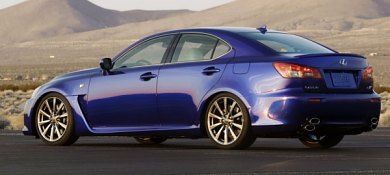
|
A split character: refined powertrain
and hot-rod ride quality
|
On
the
road, the 8-speed automatic gearbox also delivers a mixed impression.
On the one hand it is uncanny smooth in auto mode and very responsive
in manual mode. On the other hand, drivers would complain for having
too many gears. The transmission shifts automatically between gears
frequently, which is quite annoying. In manual mode, the drivers will
find the first 3 ratios too far apart, so low-gear acceleration is
frustrating. This prevent the Lexus from threatening its German rivals
on mountain roads. On the contrary, the last few ratios are too closely
stacked, thus you will need to downshift multiple gears in succession
if you are trying to overtake on highway. Why does it offer such flawed
gear ratios ? Because the transmission is transferred intact from Lexus
LS except the programming and paddle-shift mechanism. Toyota did not
want to spend more money on the transmission exclusively for this
low-volume model. What a pity.
Apart from the transmission, the V8 is also a little disappointing.
Powerful ? yes. Inspiring ? not enough. There are a couple of reasons -
first of all, it is not high-revving. Electronic speed limiter is hit
at 6800 rpm, far lower than the 8400 rpm of M3. Even the monster-sized
AMG V8 can rev to 7200 rpm. Although max power arrives at 6600 rpm, the
torque tails out quickly after 5200 rpm thus it fails to show the same
rev eagerness as the German engines. The lack of rev to play hurts its
driver satisfaction and weakens its link with motorsport technology.
One should note that this engine is derived from an existing production
engine rather than developed from blueprint like the M-power V8 or AMG
V8. Despite of the titanium valves and performance pistons / con-rods,
it is otherwise quite standard.
Another flaws of the V8 lies in its aural quality. At low speed it
sounds like a normal Lexus engine, which means close to silent. Once
the engine rev beyond 3600 rpm, opening the second stage of intake
manifolds, the induction noise becomes loud and raw. But it is still
far from musical, because it lacks an exhaust note to form an
orchestra. The result is a bland sound track. Look at the quad-exhaust
pipes, you will be shocked that half of them are fake ! This is
actually a twin-exhaust !
Now the story gets clearer... When Toyota developed the IS there was no
plan to include a high-performance model. The IS-F got approval only
after the regular IS reached production, therefore it had to compromise
with the existing mechanical boundaries. Take the chassis for example,
it gets no strengthening or revised suspension or steering geometry.
All it can do is to stiffen the springs, dampers and anti-roll bars of
the suspensions, that sort of thing. The same goes for the appearance -
the aftermarket-style fenders, skirts and pronounced bonnet are
obviously added afterwards, without a coherent design philosophy with
the rest of the body. It actually looks uglier than the standard IS.
With a big V8 hanging over the front wheels, the weight distribution
deteriorates to 54:46 front to rear. Fortunately, the IS chassis is
derived from the GS platform, thus it had little problem to handle the
V8 power. Moreover, Toyota tested it extensively in Nurburgring, during
which it found a faster steering rack and stiff suspension setup (90%
stiffer up front and 50% stiffer at the rear) could sharpen the turn-in
and eliminate the feel of nose-heaviness. On race tracks, this is
mostly successful. It corners fast and stays planted. With VDIM
traction and stability control switched off, it may even play some
power slide, albeit not as controllable as M3 because of the lack of
limited slip differential (active or passive). The huge Brembo brakes
(360mm 6-pot front; 345mm 4-pot rear) worth praising for their power
and fade-resistance. On the downside, the electric power steering
remains short of real feel.
The bad news is, its remarkable track performance could not be
transferred to public roads. Because the suspension setup is too stiff,
IS-F is difficult to live with. This limits its capability to fight
with the German performance sedans. After all, people buy performance
sedans because they are fast yet accessible for everyday use. Moreover,
the harsh ride of IS-F is ridiculous to a brand renowned for uncanny
refinement. So what is it ? a Lexus or a hot-rod ? I am puzzled.
|
| The
above report was last updated on 5 Jan 2008. All Rights Reserved. |
|
IS250C / IS350C
|
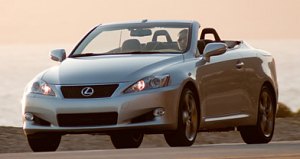 This
is Lexus' take on BMW 3-Series Cabriolet. It is also the first time
Lexus IS appears in 2-door coupe form. The coupe-cabriolet has a
3-piece retractable roof made of aluminum and built by Toyota itself.
It is well engineered, capable of opening or closing in 20 seconds.
When closed, the cabin is well insulated from the outside world and the
chassis feels reasonably stiff. Only riding on rough surfaces will show
some chassis flex and steering column vibration. The boot is the
biggest in class, measuring 584 liters with the roof up, thanks to a
lengthened rear overhang. Roof down and it is reduced to only 235
liters - but still more than BMW's 210 liters. The cabin is capable of
seating four if the rear passengers are not large. This
is Lexus' take on BMW 3-Series Cabriolet. It is also the first time
Lexus IS appears in 2-door coupe form. The coupe-cabriolet has a
3-piece retractable roof made of aluminum and built by Toyota itself.
It is well engineered, capable of opening or closing in 20 seconds.
When closed, the cabin is well insulated from the outside world and the
chassis feels reasonably stiff. Only riding on rough surfaces will show
some chassis flex and steering column vibration. The boot is the
biggest in class, measuring 584 liters with the roof up, thanks to a
lengthened rear overhang. Roof down and it is reduced to only 235
liters - but still more than BMW's 210 liters. The cabin is capable of
seating four if the rear passengers are not large.
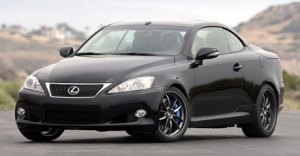 The
204hp 2.5-liter and 306hp 3.5-liter V6 are carried over from the sedan.
No diesel engine is offered because the majority of cars will be sold
in the United States, especially California. Burdened by an extra
160-170 kg, they are not as quick as the equivalent sedans, of course.
While IS350C is still capable of doing 0-60 in a respectable 5.8
seconds, IS250C takes as many as 8.4 seconds. The
204hp 2.5-liter and 306hp 3.5-liter V6 are carried over from the sedan.
No diesel engine is offered because the majority of cars will be sold
in the United States, especially California. Burdened by an extra
160-170 kg, they are not as quick as the equivalent sedans, of course.
While IS350C is still capable of doing 0-60 in a respectable 5.8
seconds, IS250C takes as many as 8.4 seconds.
Like the IS sedan, the convertible duo is not designed for driving
excitement. They just bias even more towards the comfort side, because
the loss of 15 percent in chassis torsional rigidity calls for softer
suspension setup. This reflects in more body roll, slower steering
response and a remote feeling when guiding it on back roads. On the
positive side, its ride quality is generally refined and both engines
are smooth and quiet, if somewhat lacking character. Lexus loyalists
will find its driving manner familiar. Overall, it's a decent
coupe-cabriolet, but not as good as 3-Series Cabriolet.
|
| The
above report was last updated on 5 Jul 2009. All Rights Reserved. |
|
|
 In
1999, Toyota wanted to replicate the success of BMW 3-series with its
first generation Lexus IS (and its Japanese version Toyota Altezza).
Although it tried very hard, and surprised motoring journalists by its
sharp handling, it didn't quite succeed. First of all, the IS looked
ugly compare with an European premium car. Secondly, the IS200 was
underpowered, while IS300 was nose heavy (blame to that Supra-sourced
iron-block straight-6). Thirdly, it was less rounded than the BMW, no
matter the way it dealt with road irregularities or high speed
cruising. Lastly, its hardcore character was out of sync with Lexus'
creamy smooth character.
In
1999, Toyota wanted to replicate the success of BMW 3-series with its
first generation Lexus IS (and its Japanese version Toyota Altezza).
Although it tried very hard, and surprised motoring journalists by its
sharp handling, it didn't quite succeed. First of all, the IS looked
ugly compare with an European premium car. Secondly, the IS200 was
underpowered, while IS300 was nose heavy (blame to that Supra-sourced
iron-block straight-6). Thirdly, it was less rounded than the BMW, no
matter the way it dealt with road irregularities or high speed
cruising. Lastly, its hardcore character was out of sync with Lexus'
creamy smooth character.  The new Lexus IS is noticeably
bigger than the car it replaced. Compare with the latest E90 3-Series,
it is 55 mm longer but 22 mm narrower. The 2730 mm wheelbase is 60 mm
longer than the outgoing car, but still 30 mm shorter than the BMW.
Basically, you can see it as a smaller version of Lexus GS. It shares
platform with its bigger brother, i.e. aluminum double wishbone front
and multi-link rear suspensions, speed-sensitive electric power
steering, 6-speed automatic transmission with paddle shift, VDIM
vehicle dynamic integrated management program…. however, to save money
and to please keen drivers, the VGRS variable ratio steering rack has
been deleted.
The new Lexus IS is noticeably
bigger than the car it replaced. Compare with the latest E90 3-Series,
it is 55 mm longer but 22 mm narrower. The 2730 mm wheelbase is 60 mm
longer than the outgoing car, but still 30 mm shorter than the BMW.
Basically, you can see it as a smaller version of Lexus GS. It shares
platform with its bigger brother, i.e. aluminum double wishbone front
and multi-link rear suspensions, speed-sensitive electric power
steering, 6-speed automatic transmission with paddle shift, VDIM
vehicle dynamic integrated management program…. however, to save money
and to please keen drivers, the VGRS variable ratio steering rack has
been deleted.  Admittedly, IS350 does not have
any manual gearbox on offer. If you insist to shift by yourself, you
can choose only IS250, whose 2.5-litre V6 pumps out 204 horsepower.
This is less than BMW 325i (218hp) and, unfortunately, it is also the
car European market will be offered. Another engine for Europe is a 177
hp 2.2-litre common rail diesel four cylinder engine. It shares with
Toyota Avensis.
Admittedly, IS350 does not have
any manual gearbox on offer. If you insist to shift by yourself, you
can choose only IS250, whose 2.5-litre V6 pumps out 204 horsepower.
This is less than BMW 325i (218hp) and, unfortunately, it is also the
car European market will be offered. Another engine for Europe is a 177
hp 2.2-litre common rail diesel four cylinder engine. It shares with
Toyota Avensis. Open the doors, you will be
amazed by how cramped the rear cabin is. Although the car is much
larger than the old one, it is no more spacious inside. Tall passengers
will find legroom and headroom tight at the rear seats. The GS with
equivalent engine is just 40 kg heavier, but it offers a much roomier
cabin. Seems that the new IS does not use space and weight efficiently.
Open the doors, you will be
amazed by how cramped the rear cabin is. Although the car is much
larger than the old one, it is no more spacious inside. Tall passengers
will find legroom and headroom tight at the rear seats. The GS with
equivalent engine is just 40 kg heavier, but it offers a much roomier
cabin. Seems that the new IS does not use space and weight efficiently.
 The big V6 is still very smooth
and quiet, probably too quiet for a sports sedan. Nevertheless, when
you ask from it, its flat power band delivers storming acceleration so
effortlessly. The sports suspensions with aggressive rubbers keep the
body well controlled. The big brakes (come from GS430) provide
excellent stopping power.
The big V6 is still very smooth
and quiet, probably too quiet for a sports sedan. Nevertheless, when
you ask from it, its flat power band delivers storming acceleration so
effortlessly. The sports suspensions with aggressive rubbers keep the
body well controlled. The big brakes (come from GS430) provide
excellent stopping power.  This
is Lexus' take on BMW 3-Series Cabriolet. It is also the first time
Lexus IS appears in 2-door coupe form. The coupe-cabriolet has a
3-piece retractable roof made of aluminum and built by Toyota itself.
It is well engineered, capable of opening or closing in 20 seconds.
When closed, the cabin is well insulated from the outside world and the
chassis feels reasonably stiff. Only riding on rough surfaces will show
some chassis flex and steering column vibration. The boot is the
biggest in class, measuring 584 liters with the roof up, thanks to a
lengthened rear overhang. Roof down and it is reduced to only 235
liters - but still more than BMW's 210 liters. The cabin is capable of
seating four if the rear passengers are not large.
This
is Lexus' take on BMW 3-Series Cabriolet. It is also the first time
Lexus IS appears in 2-door coupe form. The coupe-cabriolet has a
3-piece retractable roof made of aluminum and built by Toyota itself.
It is well engineered, capable of opening or closing in 20 seconds.
When closed, the cabin is well insulated from the outside world and the
chassis feels reasonably stiff. Only riding on rough surfaces will show
some chassis flex and steering column vibration. The boot is the
biggest in class, measuring 584 liters with the roof up, thanks to a
lengthened rear overhang. Roof down and it is reduced to only 235
liters - but still more than BMW's 210 liters. The cabin is capable of
seating four if the rear passengers are not large. The
204hp 2.5-liter and 306hp 3.5-liter V6 are carried over from the sedan.
No diesel engine is offered because the majority of cars will be sold
in the United States, especially California. Burdened by an extra
160-170 kg, they are not as quick as the equivalent sedans, of course.
While IS350C is still capable of doing 0-60 in a respectable 5.8
seconds, IS250C takes as many as 8.4 seconds.
The
204hp 2.5-liter and 306hp 3.5-liter V6 are carried over from the sedan.
No diesel engine is offered because the majority of cars will be sold
in the United States, especially California. Burdened by an extra
160-170 kg, they are not as quick as the equivalent sedans, of course.
While IS350C is still capable of doing 0-60 in a respectable 5.8
seconds, IS250C takes as many as 8.4 seconds. The answer is again no. First
to take the responsibility is the diesel engine. While the spec looks
good (aluminum block, 16 valves, 1800 bar piezo-electronic
third-generation common-rail injection and variable vane turbocharger),
and the ultimate power is strong, the engine is rather weak below 2000
rpm. There is a slight turbo lag that rarely associate with a premium
diesel engine today. Ditto the booming noise at hard work and the
vibration through the pedals. You won't see this in BMW, Mercedes and
Audi's diesel engine, but you will see exactly the same things at a
Toyota Avensis and Corolla Verso diesel, because they actually share
the same engine. This is undoubtedly a disappointment to a brand
traditionally so strong at refinement.
The answer is again no. First
to take the responsibility is the diesel engine. While the spec looks
good (aluminum block, 16 valves, 1800 bar piezo-electronic
third-generation common-rail injection and variable vane turbocharger),
and the ultimate power is strong, the engine is rather weak below 2000
rpm. There is a slight turbo lag that rarely associate with a premium
diesel engine today. Ditto the booming noise at hard work and the
vibration through the pedals. You won't see this in BMW, Mercedes and
Audi's diesel engine, but you will see exactly the same things at a
Toyota Avensis and Corolla Verso diesel, because they actually share
the same engine. This is undoubtedly a disappointment to a brand
traditionally so strong at refinement.


 IS220d
IS220d Hide all
Hide all
